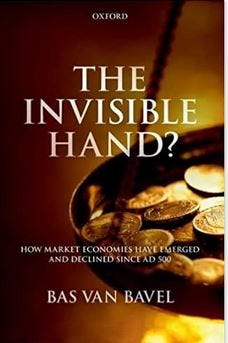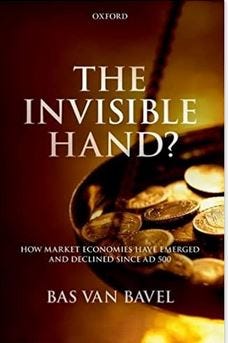A theory of the rise and fall of economic leadership
Review of Bas van Bavel’s “The Invisible Hand?”
The recently published “The invisible hand?: How market economies have emerged and declined since AD 500” (Oxford University Press, 2016, 330 pages) by Bas van Bavel has, like all important books, a relatively simple core theory which Van Bavel, a well-known economic historian teaching at the University of Utrecht, illustrates on five historical examples: Iraq between 500 and 1100, Central and Northern Italy 1000-1500, the Low Countries 1100-1800, England 1800-1900, and the United States 1800-today. (The first three cases are discussed in detailed separate chapters, each running to 50-60 pages, while the last two, to which Western Europe may be appended, are discussed in a single chapter called “Epilogue”).
Van Bavel’s key idea is as follows. In societies where non-market constraints are dominant (say, in feudal societies), liberating factor markets is a truly revolutionary change. Ability of peasants to own some land or to lease it, of workers to work for wages rather than to be subjected to various types of corvées, or of the merchants to borrow at a more or less competitive market rather than to depend on usurious rates, is liberating at an individual level (gives person much greater freedom), secures property, and unleashes the forces of economic growth. The pace of activity quickens, growth accelerates (true, historically, from close to zero to some small number like 0.5% per year) and even inequality, economic and above all social, decreases. This is the period so well recognized and analyzed by Adam Smith. Van Bavel, in a nod to Braudel, shows that very similar “essors” have existed in the pre-medieval Iraq (then the most developed part of the world), medieval Central and Northern Italy (Florence, Venice, Milan, Genoa..) and on the cusp between the late medieval Europe and early modern period in the Low Countries.
But the process, Bavel argues, contains the seeds of its destruction. Gradually factor markets cover more and more of the population: Bavel is excellent in providing numerical estimates on, for example, the percentage of wage-earners in Lombardy in the 14th century or showing that in Low Countries wage labor was, because of guilds, less prevalent in urban than in rural areas. One factor market, though, that of capital and finance, gradually begins to dominate. Private and public debt become most attractive investments, big fortunes are made in finance, and those who originally asked for the level playing field and removal of feudal-like constraints, now use their wealth to conquer the political power and impose a serrata, thus making the rules destined to keep them forever on the top. What started as an exercise in political and economic freedom begins to look like an exercise in cementing the acquired power, politically and economically. The economic essor is gone, the economy begins to stagnate and, as happened to Iraq, Northern Italy and Low Countries, is overtaken by the competitors.*
As this short sketch shows, Bavel’s theory has many links, or can be juxtaposed, to several contemporary views of economic history. Bavel is dismissive of a unilinear view that regards the ever widening role of factor markets, including the financial, as leading to ever higher incomes and greater political freedom. His view, although not fully cyclical (on which I will say a bit more at the very end of the review) is “endogenously curvilinear”: things which were good originally, when they hypertrophy, become a hindrance to further growth. It is thus a story of the rise and fall where, like in Greek tragedies, the very same factors that brought the protagonists grandeur, eventually hurl them into the abyss.
Bavel’s view is at variance with recent theories proposed by Acemoglu and Robinson as well as by Landes, or even by McCloskey (although I write this based on the reviews and a couple of short articles; I have not read her “Bourgeois Virtues”). Unilineal theories are, according to Bavel, ahistorical and unduly Euro-centric. They ignore very similar developments in other parts of the world and, while Bavel does not discuss it in the book, he mentions, Roman Empire, Song China and Byzantium. By focusing on Europe only, and its increase in real income which parallels the growing marketization of the economy from the 18th century to today, such theories fail to acknowledge the elements of economic decadence.
This brings me to a point where, in my opinion, Bavel’s approach could have been made more effective. In the introduction and in the very detailed discussion of the three cases, Bavel speaks of a real income rise and decline, that is of the economies that have become rich and then declined and got impoverished. This is especially evident for Iraq and Northern Italy, and slightly less so for the Low Countries. But when he discusses even the Low Countries at the end of their “Golden Age” and all the later cases, the decline is a relative one, that is, it is only when compared to other competitors. Thus, the Low Countries were overtaken by England, the latter is overtaken by the United States, and (we are led to extrapolate) the United States will be overtaken by China. Thus, in my reading of the book, Bavel discusses the rise and fall of economic powers which would be a more effective way to present his central thesis and to solve a facile (and in my opinion wrong, but to some perhaps fatal) objection that the Netherlands or England can hardly be said to have declined if their today’s real incomes are twenty or more times greater than what they were at their (relative) “peaks”.
It is not only the plausibility of the mechanism of decline that gives strength to Bavel’s thesis; it is also that he lists the manifestation of the decline, observable in all six cases. Financial investments yield much more than investments in the real sector, the economy begins to resemble a casino, the political power of the financiers becomes enormous. The richest among the financiers either directly or indirectly enter politics, they become patrons of arts, sponsors of sports and education, and we witness simultaneously (1) oligarchic politics, (2) slower growth and lower level of real investments, (3) higher inequality, (4) domination of finance and (5) artistic efflorescence. What the ancient writers describe as “decadence” clearly sets it, but, as Bavel is at pains to note, it is not caused by moral defects of the ruling class but by the type of economy that is being created. Extravagant bidding for assets whose quantity is fixed (land and art) is a further manifestation of such an economy: the bidding for fixed assets reflects lack of alternative profitable investments as well as the expectation that, as inequality increases, there would be some even crazier and richer investors who would pay even more for a work of art, thus enabling the realization of a capital gain.
The readers will not be remiss in seeing clear analogies to today’s West.
Let me end with the point about the cycles. Bavel’s theory is not fully cyclical, in the way that (say) Plato‘s was where each political system led to another one, in an endless cycle. In Bavel, after the relative fall, the economies do not seem to recover, although it is possible to imagine that, if the shackles of finance and inequality were broken, a Phoenix-like recovery should not be excluded (leading perhaps in its turn to another decadence).
* Strictly speaking, Van Bavel distinguishes three stages: market economy (output markets and security of property), accumulation (wage labor, capital accumulation, and growth), capitalism (dominance of the financial sector, use of the state by capitalists, monopolization)
.



Great review, I will definitely check this one out. I'm in the middle of The Dawn of Everything by David Graeber and David Wengrow right now and it seems like many people (myself included) could benefit from a less Euro-centric view of history. I have had many conversations with friends who didn't believe certain political, economic, or social arrangements were possible, only for me to learn later that those arrangements have been implemented successfully in some societies or circumstances. It really dampens the imagination and limits the possibility of your world to only understand a "Western" view of history and society.
A similar thesis was proposed by two Canadian authors some time ago:
Jonathan Nitzan and Shimshon Bichler - Capital as Power A Study of Order and Creorder